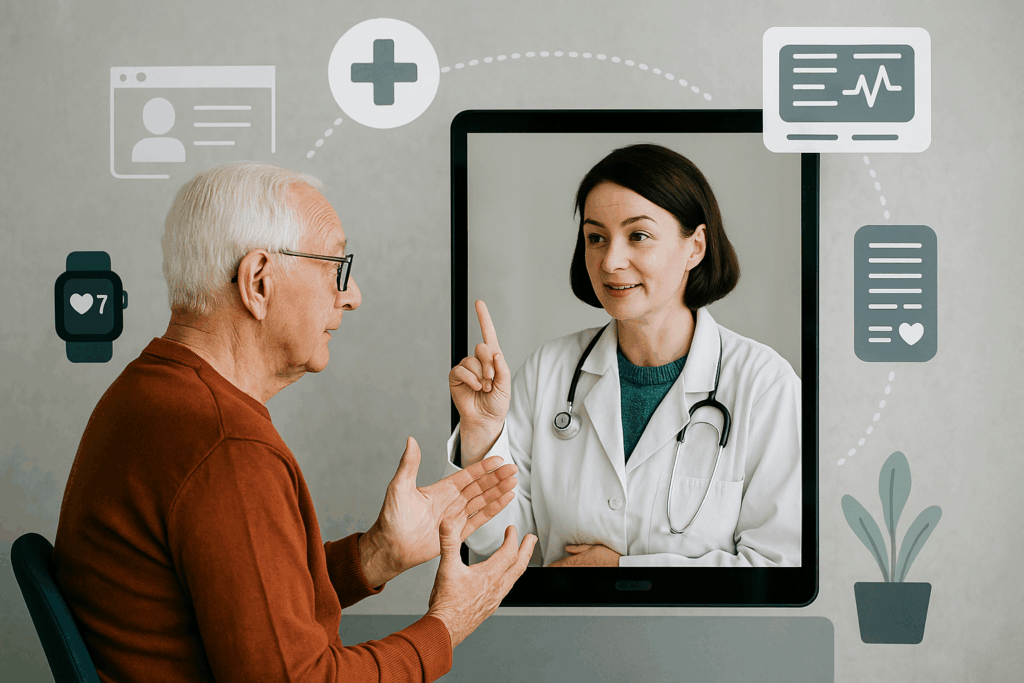
How remote monitoring and digital healthcare are transforming medical care in Italy
A new paradigm for medicine
In recent years, the Italian healthcare system has embarked on a path of deep innovation. The push toward digital healthcare and remote monitoring is transforming traditional models of care, making them more proactive, personalized, and accessible. Demographic factors such as an aging population (with over 24% of Italians now over 65, according to ISTAT), the rise in chronic diseases, and the challenges brought on by the pandemic have highlighted the urgent need to modernize the National Health Service.
Technologies such as telemedicine, wearable devices, and health data management platforms are redefining care, allowing patients to be followed remotely and enabling doctors to continuously monitor clinical conditions that, just a few years ago, would have required frequent in-person visits.
Growth of digital healthcare: investments and new practices
In Italy, spending on digital healthcare solutions reached €2.47 billion in 2024, up 12% from the previous year. Much of this investment has been driven by the PNRR, which allocated around €1 billion for telemedicine, with the goal of promoting new models of community-based care.
Today, more than 50% of General Practitioners and around 36% of specialists in Italy have already used teleconsultation or remote monitoring services, though adoption is still somewhat fragmented. At the same time, use of the Electronic Health Record (FSE) is also growing: over 40% of citizens have activated access to their records, and 60% of these have given consent to share clinical data clear evidence of growing awareness of the importance of digitalization.
These signs show that Italian healthcare is progressively embracing innovation, though at varying speeds across different regions and facilities.
The value of remote monitoring for chronic patients
Remote monitoring is one of the most promising pillars for managing chronic conditions. With connected devices for monitoring blood pressure, blood glucose, and heart function, patients can be followed from home reducing avoidable hospitalizations and improving quality of life.
Currently, around 12% of chronic patients in Italy have already used remote monitoring services, but the potential is much greater. Initiatives launched in some regions (such as Emilia-Romagna and Tuscany) during the pandemic have shown how structured monitoring can prevent flare-ups and optimize the use of hospital resources.
Particularly interesting are the telecardiology projects in pharmacies: today, 80% of Italian pharmacies are equipped to perform ECGs with remote reporting, with over 900,000 procedures delivered in 2024. These numbers show how community-based services beyond hospitals are becoming a key point of care for vulnerable patients.
Telemedicine and widespread community-based care
Telemedicine understood as the full range of services from teleconsultations to specialist-to-specialist consultations has now become an essential component of healthcare. In 2023–2024, the number of teleconsultations in Italy rose by more than 170% compared to the previous year, with strong growth also seen in cardiology and diabetology teleconsultations.
This growth is also supported by the new community-based care model: the “Case di Comunità” (Community Health Centers) framework, introduced by the DM 77/2022 reform, aims to integrate digital services with traditional care. Regional telemedicine platforms are in advanced stages of development, and the National Telemedicine Platform (PNT), coordinated by AGENAS, already targets providing care for 300,000 patients by the end of 2025.
The result will be increasingly widespread care, capable of connecting specialists, general practitioners, pharmacies, and patients with significant benefits in terms of accessibility and reduced waiting times.
Benefits for patients and healthcare professionals
For patients especially those who are chronic or vulnerable the ability to be monitored remotely offers significant advantages: greater clinical safety, fewer trips to care facilities, and more personalized treatment. In addition, by integrating data between the Electronic Health Record (FSE) and monitoring platforms, the various healthcare professionals involved can collaborate more efficiently.
For doctors, having access to up-to-date data enables earlier interventions and reduces administrative workload. According to estimates from the Digital Healthcare Observatory, structured use of digital platforms could save general practitioners more than a full workweek per year.
Finally, the integration of artificial intelligence into remote monitoring platforms is paving the way for more predictive medicine: machine learning algorithms are already helping to identify trends and potential clinical risks, enabling preventive interventions.
Future prospects and challenges ahead
The path toward a fully mature digital healthcare system is still evolving. Key challenges include the need for greater digital training for healthcare professionals, strengthening technological infrastructure (such as high-speed connections and system interoperability), and protecting sensitive data.
It is also essential to ensure the financial sustainability of projects launched with extraordinary PNRR funding, so that digital services become a structural and permanent part of healthcare delivery.
The opportunities, however, are enormous. As highlighted in the recent 2025 ISTAT Health Report, the integration of remote monitoring, telemedicine, and artificial intelligence can be a decisive driver in building a more equitable, sustainable, and citizen-centered healthcare system.
The path is clear: it’s time to move forward with vision and determination.
